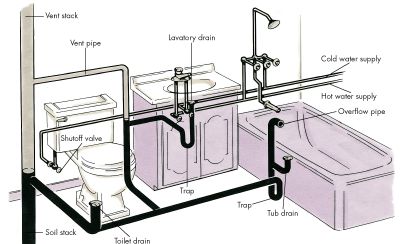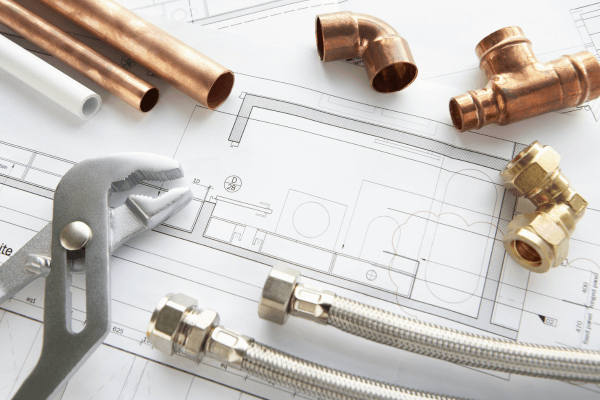Key Information About Your Home's Plumbing System Anatomy
Key Information About Your Home's Plumbing System Anatomy
Blog Article
The article following next on the subject of Exploring Your Homes Plumbing Anatomy is exceedingly informative. Give it a go and make your own personal results.

Understanding exactly how your home's pipes system functions is vital for every home owner. From delivering tidy water for drinking, food preparation, and showering to safely getting rid of wastewater, a well-maintained pipes system is vital for your family members's wellness and convenience. In this detailed overview, we'll check out the elaborate network that makes up your home's pipes and offer tips on upkeep, upgrades, and managing usual issues.
Intro
Your home's plumbing system is more than simply a network of pipes; it's a complex system that guarantees you have access to tidy water and effective wastewater removal. Recognizing its components and just how they collaborate can help you protect against costly fixings and make certain every little thing runs efficiently.
Basic Components of a Pipes System
Pipes and Tubes
At the heart of your plumbing system are the pipelines and tubing that carry water throughout your home. These can be made from various products such as copper, PVC, or PEX, each with its advantages in regards to sturdiness and cost-effectiveness.
Components: Sinks, Toilets, Showers, etc.
Fixtures like sinks, commodes, showers, and bathtubs are where water is made use of in your house. Comprehending how these fixtures attach to the plumbing system helps in detecting problems and intending upgrades.
Valves and Shut-off Points
Shutoffs control the circulation of water in your plumbing system. Shut-off shutoffs are crucial during emergency situations or when you need to make repair services, allowing you to isolate parts of the system without interfering with water flow to the entire residence.
Supply Of Water System
Main Water Line
The primary water line links your home to the metropolitan supply of water or an exclusive well. It's where water enters your home and is distributed to different components.
Water Meter and Stress Regulator
The water meter procedures your water use, while a pressure regulator makes sure that water moves at a safe pressure throughout your home's pipes system, preventing damage to pipelines and components.
Cold Water vs. Hot Water Lines
Understanding the distinction in between cold water lines, which provide water straight from the main, and hot water lines, which carry heated water from the hot water heater, aids in troubleshooting and planning for upgrades.
Drain System
Drain Pipeline and Traps
Drain pipelines carry wastewater far from sinks, showers, and commodes to the drain or septic system. Traps stop sewage system gases from entering your home and also catch particles that can cause clogs.
Ventilation Pipelines
Air flow pipes enable air right into the drainage system, stopping suction that can slow drain and create catches to empty. Appropriate ventilation is necessary for preserving the honesty of your pipes system.
Significance of Appropriate Water Drainage
Ensuring appropriate drain protects against backups and water damage. On a regular basis cleaning up drains pipes and keeping traps can avoid costly repair work and prolong the life of your pipes system.
Water Furnace
Sorts Of Water Heaters
Water heaters can be tankless or conventional tank-style. Tankless heating units heat water on demand, while tanks save heated water for immediate use.
How Water Heaters Connect to the Plumbing System
Understanding how water heaters connect to both the cold water supply and hot water distribution lines assists in identifying problems like inadequate hot water or leakages.
Maintenance Tips for Water Heaters
Routinely purging your water heater to remove debris, inspecting the temperature setups, and checking for leaks can extend its life-span and enhance energy effectiveness.
Usual Plumbing Issues
Leakages and Their Causes
Leakages can happen due to maturing pipelines, loosened installations, or high water pressure. Dealing with leaks promptly protects against water damage and mold and mildew development.
Obstructions and Obstructions
Blockages in drains pipes and bathrooms are typically triggered by purging non-flushable things or a build-up of oil and hair. Making use of drainpipe displays and bearing in mind what drops your drains pipes can prevent obstructions.
Indications of Plumbing Problems to Expect
Low tide pressure, sluggish drains pipes, foul odors, or abnormally high water bills are indications of potential pipes issues that should be addressed without delay.
Plumbing Upkeep Tips
Routine Evaluations and Checks
Schedule yearly plumbing evaluations to capture issues early. Seek signs of leakages, corrosion, or mineral accumulation in faucets and showerheads.
Do It Yourself Upkeep Tasks
Easy jobs like cleaning faucet aerators, looking for commode leakages utilizing dye tablet computers, or insulating subjected pipelines in cold environments can prevent significant pipes issues.
When to Call an Expert Plumbing Professional
Know when a pipes issue requires expert know-how. Attempting complex repair services without appropriate expertise can lead to more damages and greater repair work expenses.
Updating Your Plumbing System
Factors for Upgrading
Upgrading to water-efficient components or changing old pipes can boost water quality, decrease water expenses, and raise the worth of your home.
Modern Plumbing Technologies and Their Benefits
Discover technologies like wise leakage detectors, water-saving toilets, and energy-efficient water heaters that can conserve money and minimize ecological impact.
Expense Factors To Consider and ROI
Compute the upfront expenses versus long-lasting savings when taking into consideration plumbing upgrades. Several upgrades pay for themselves via decreased energy costs and fewer fixings.
Environmental Influence and Conservation
Water-Saving Fixtures and Devices
Installing low-flow taps, showerheads, and toilets can substantially reduce water usage without giving up performance.
Tips for Decreasing Water Use
Basic routines like taking care of leaks immediately, taking shorter showers, and running complete tons of washing and meals can conserve water and reduced your utility costs.
Eco-Friendly Plumbing Options
Consider sustainable pipes products like bamboo for flooring, which is durable and green, or recycled glass for countertops.
Emergency situation Readiness
Steps to Take During a Pipes Emergency situation
Know where your shut-off valves are located and just how to shut off the supply of water in case of a ruptured pipe or major leakage.
Significance of Having Emergency Situation Calls Handy
Maintain get in touch with info for regional plumbing technicians or emergency situation services easily available for quick response throughout a pipes crisis.
Do It Yourself Emergency Fixes (When Appropriate).
Short-lived solutions like utilizing duct tape to patch a dripping pipeline or putting a container under a dripping faucet can decrease damages up until a specialist plumbing professional gets here.
Final thought.
Recognizing the composition of your home's plumbing system empowers you to keep it successfully, saving time and money on fixings. By adhering to routine maintenance regimens and staying notified about modern pipes modern technologies, you can guarantee your plumbing system runs effectively for years ahead.
Understanding Your Home Plumbing System: A Comprehensive Guide
Plumbing System: The Lifeline of Your Home
At its core, the plumbing system is designed to perform two primary functions: bring fresh water into your home and remove wastewater. The system is a network of pipes, fixtures, and other components that transport water and sewage. Residential plumbing systems include potable water supply lines, drain-waste-vent (DWV) systems, and various plumbing fixtures that make water use in daily tasks possible.
Key Components:
Water Supply: This part of your plumbing system brings municipal water into your home, passing through the main water supply line. It s responsible for supplying all water needs, from drinking to bathing.
Drainage System: It carries waste and water away from your home to the sewer or septic system. This system includes all the piping within your home that leads to external sewage or septic systems.
Vent System: An essential yet often overlooked component, the vent system allows sewer gases to escape and lets air into the drainpipes, ensuring water and waste move correctly through the system.
Fixture: More Than Just Taps and Toilets
Plumbing fixtures are the most interactive parts of the plumbing system, including faucets, showers, toilets, and sinks. Each fixture is connected to the plumbing system and plays a role in either the delivery of freshwater or the disposal of waste and wastewater.
Types of Fixtures:
Faucets and Sinks: Used for washing hands, dishes, and other daily water needs.
Toilets: Dispose of human waste through the sewage system.
Bathtubs and Showers: Provide bathing facilities, requiring both hot and cold water supply.
Water Supply: The Source of Life
The water supply system is a critical component, ensuring that potable water is available throughout your home for various uses, including drinking, cooking, and cleaning. This system consists of pipes that distribute water to different parts of the house, controlled by valves to regulate the water flow.
Types of Plumbing: Materials and Methods
Various types of plumbing systems and materials are used in residential settings, each with its advantages and applications. From copper and PVC pipes for water supply to cast iron and ABS for drainage, the choice of materials can impact the longevity and efficiency of your plumbing system.
https://intownplumbingtx.com/articles/home-plumbing-system-guide/

Understanding Your Home Plumbing System: A Comprehensive Guide
Plumbing System: The Lifeline of Your Home
At its core, the plumbing system is designed to perform two primary functions: bring fresh water into your home and remove wastewater. The system is a network of pipes, fixtures, and other components that transport water and sewage. Residential plumbing systems include potable water supply lines, drain-waste-vent (DWV) systems, and various plumbing fixtures that make water use in daily tasks possible.
Key Components:
Water Supply: This part of your plumbing system brings municipal water into your home, passing through the main water supply line. It s responsible for supplying all water needs, from drinking to bathing.
Drainage System: It carries waste and water away from your home to the sewer or septic system. This system includes all the piping within your home that leads to external sewage or septic systems.
Vent System: An essential yet often overlooked component, the vent system allows sewer gases to escape and lets air into the drainpipes, ensuring water and waste move correctly through the system.
Fixture: More Than Just Taps and Toilets
Plumbing fixtures are the most interactive parts of the plumbing system, including faucets, showers, toilets, and sinks. Each fixture is connected to the plumbing system and plays a role in either the delivery of freshwater or the disposal of waste and wastewater.
Types of Fixtures:
Water Supply: The Source of Life
The water supply system is a critical component, ensuring that potable water is available throughout your home for various uses, including drinking, cooking, and cleaning. This system consists of pipes that distribute water to different parts of the house, controlled by valves to regulate the water flow.
Types of Plumbing: Materials and Methods
Various types of plumbing systems and materials are used in residential settings, each with its advantages and applications. From copper and PVC pipes for water supply to cast iron and ABS for drainage, the choice of materials can impact the longevity and efficiency of your plumbing system.
https://intownplumbingtx.com/articles/home-plumbing-system-guide/
Do you really like more info about Exploring Your Homes Plumbing Anatomy? Post a comment directly below. We would be delighted to hear your insights about this write-up. In hopes to see you back again later on. Are you aware of somebody who is fascinated about Anatomy of a House: Understanding the Components? Be sure promote it. I take joy in your readership.
Click Here Report this page